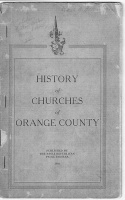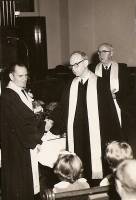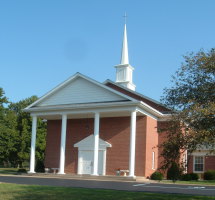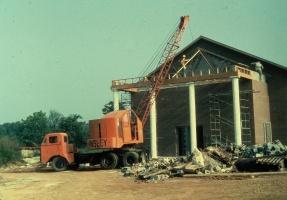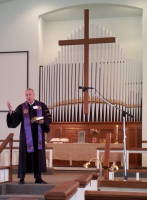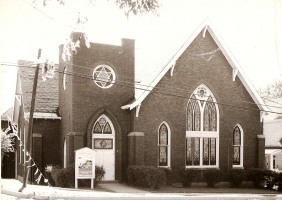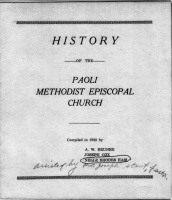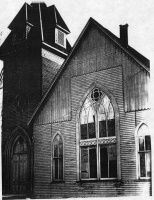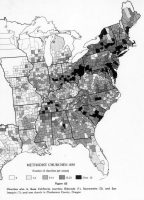History of Churches of Orange County
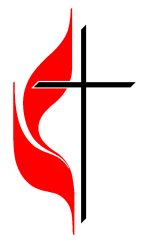
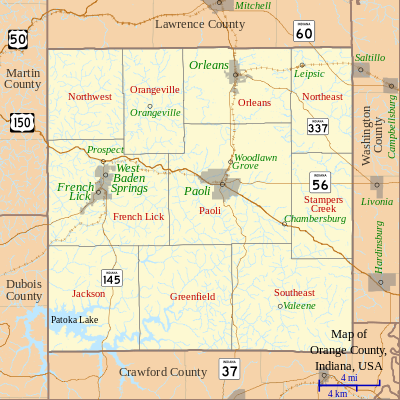
The booklet History of Churches of Orange County dates from 1940.
We have scanned the booklet and converted it to a PDF file. Click here or on the image below to open the document, or right-click to save it to your system for later reading.
Given the size of the document (26 MB), unless you have a fast Internet connection you may prefer to save it to your local system so you only have to download it once.
Below are extracts of the text covering the Methodist and United Brethren churches in the county — the three towns first and then the churches in the surrounding townships.
Other than cleaning up some spelling and typesetting errors, and clarifying some abbreviations and date references, we have reproduced the text as it appears in the original. You will find that the wording is a little flowery in places, and commas seem to have been much more popular around 1940. We scanned this document with XSane and converted it to text with the help of Gocr.
Paoli
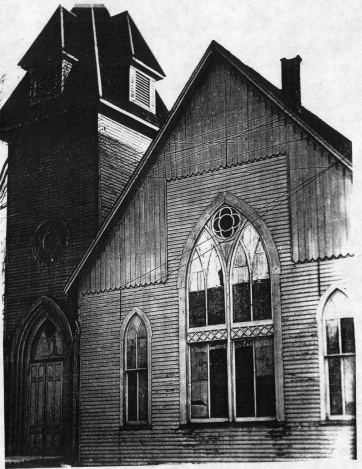
Paoli Methodist Church
Methodism followed immediately the founding of the town in 1816, the first services being held in the homes, followed later with meetings in the first courthouse on the northwest corner of the public square.
The first ministers were known as "circuit riders." They served, in addition to Paoli, similar organizations at French Lick, Orangeville, Nelson Chapel, Bond's, Kirby's, Island, and Moore's Ridge, all in Orange county. One of the pioneer ministers, sometimes called the Demosthenes of the west, was Rev. William Beauchamp, who died in Paoli in 1824 and is buried in the old cemetery here. Other ministers of this early class were Bishop Roberts, Rev. Francis Walker, and Bishop Asbury, whose circuit riding was perhaps greater than that of any other.
Early families who worshiped with this church in Paoli were the Jacksons, Osbornes, Kirbys, Moores, Mcveys, Throops, Giffords, Millises, Stuckers, and Wilsons, all which are familiar names here today. They listened to such men of God as Peter Cartwright, Lorenzo Dow, and John Strange, in addition to those already named.
John Throop, the father of Miss Sarah and Miss Jane Throop, was the founder of the Methodist Sunday school. He was also one of the first trustees in the church.
The first Methodist church was erected in 1839, and stood on the site of the present Methodist parsonage. The building itself was financed by both Methodists and Presbyterians, being used for several years by both denominations.
This church differed from the present in that there were two front doors, one leading to the men's side and one to the women's side of the church. Among those who occupied places in the choir at that time were Mrs. Benjamin D. Stinson and Miss Sena Cox, a member of the faculty of the Paoli schools at that time.
During the life of this church, Rev. J. A. Scammahorn conducted a great revival during which 169 converts and 75 new members to the church were received. During this revival the schools, then headed by Professor W. E. Pinkham, were dismissed and held sessions of prayer because of the interest in this revival.
The present church was built in 1881, at a cost of $2175. When completed, the Rev. J. S. Woods, D.D., of New Albany preached the dedicatory service and in the afternoon Rev. Scammahorn returned to deliver the Gospel message. The pastor at the time of this dedication was Rev. M. S. Heavenridge.
This church has undergone various improvements, the most extensive being in 1923, during the pastorate of the Rev. George Dalrymple, at which time a recreation room was added in the rear, basement rooms, including dining room, kitchen, and class room were added, and memorial windows installed, as well as brick veneering the exterior of the church. When this was completed, Rev. J. W. McFall, a former pastor, returned and delivered the dedicatory sermon. During the pastorate of Rev. H. D. Bassett, a pipe organ was also installed in the church. The interior of the church has recently been redecorated, and this church is now a beautiful place in which to worship God.
During the nineties, the Epworth League, and Ladies' Aid, and the Women's Foreign Missionary Society were organized. The League was organized by Rev. W. S. Rader, and was among the first chapters in the state. Mrs. Christian Pro was the first president of the Ladies' Aid, and Mrs W. M. Baggerly was the first president of the Women's Foreign Missionary Society. The surviving charter members of the last named organization are Miss Sarah Throop and Mrs. Charles Harrison.
The list of pastors of this church since its last organization is too great for all to be mentioned, but, sufficed to say, that the list includes 63 pastors who have served this church. Those of more recent years include the following: W. S. McAllister, F. T. Hoon, H. W. Baldridge, J. A. Breeden, J. W. McFall, R. W. Raff, O. E. Haley, Elmer St. Clair, W. L. Alexander, John Asher, George Dalrymple, H. D. Bassett, R. O. LaHue, L. C. Murr, M. Brittingham, Joseph L. Stout, Theron Castleman, and Donald M. Boyd, the present pastor of the church.
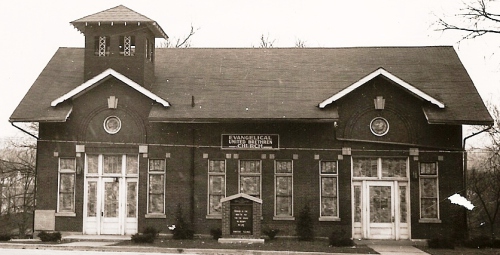
United Brethren
Rev. A. B. Condo tells us that this is the "youngest child" of the United Brethren churches in Orange county. Being the county seat town and with several churches, it would have seemed quite likely that the United Brethren church would have long since been entered into the town, but the Church of the United Brethren in Christ has always been interested in rural work in Indiana, and because of these rural churches so near the town it did not seem so necessary that they come into the town. However, at different times prior to the institution of the church with the town they owned at least two parsonages in Paoli where the ministers lived and served the nearby churches then located in the county.
During these years many United Brethren people moved into Paoli, and most of them went into other churches, since there was no church of their denomination in the town, and so came the need and the desire for a United Brethren church in Paoli.
In July, 1924, the Indiana conference secured the services of Rev. Robert Earls, evangelist of Tennessee, and George Catt, evangelistic singer, and under the supervision of the Rev. W. H. Lutes, the superintendent of Indiana conference at that time, a tent meeting was held, which resulted in a gracious revival. A church society was organized at once, with a class of more than 60 charter members, among whom was the Rev. M. E. Apple, who served as the first pastor the remainder of that conference year. The new church held regular services, including Sunday school in the courthouse for about two years. Among the charter members of the church are found the names of Young, Willard, Hickman, White, James, Brown, Love, Lindley, Apple, Harned, Carter, Gobble, and others.
At the annual conference of 1924, the Paoli church was placed on the Leipsic charge, and the Rev. C. H. Ivy was assigned as pastor.
During that year, the church class purchased a lot upon which to build a church, but the building was not started that year. Under Rev. Ivy's pastorate a Ladies' Aid was organized which was very active from the beginning in securing funds to aid the new building enterprise.
At the annual conference in 1925, Paoli was made a station and the Rev. A. B. Condo assigned as pastor. During the month of October, 1925, the church purchased the brick building on West Main street which it occupies at the present time. They remodeled the building and made it into an adequate church. The lot previously purchased, they platted for a cemetery, which the church still owns and where cemetery lots are at sale at a reasonable price.
During Rev. Condo's pastorate, he organized Christian Endeavor which has continued active throughout these 14 years.
In the conference of 1927, the Rev. W. S. Brandenburg received his appointment as pastor of Paoli church, and is now beginning his thirteenth consecutive year as pastor of the church.
During Rev. Brandenburg's pastorate, the Women's Missionary society, the Girls' Missionary society, known as the Otterbein Guild, and the intermediate and junior departments of Christian Endeavor have been organized.
Since its organization in 1924, the church has had a steady growth, its present membership being 321. The average Sunday school attendance for the past year was 144, while the record attendance for the year was 274.
Now since the United Brethren church is rather new in Paoli, it might be of interest to some readers to know a little history of the organization of that denomination. The United Brethren in Christ was the first new protestant denomination organized on American soil. It is not a split, not a branch off some other denomination, but strictly a new church, organized in 1800 by Philip William Otterbein, a missionary to America from the German Reformed church in Germany, assisted by Margin Boehm, a Mennonite missionary in America. These men became the first bishops of the new church. This organization was the result of a meeting which Martin Boehm was conducting in Isaac Long's barn near Lancaster, Pennsylvania, in 1766. Philip William Otterbein, serving a pastorate at York, Pennsylvania, attended Boehm's revival, and after listening to Boehm's eloquent testimony of Christian faith, clasped Martin Boehm's hand, and exclaimed, "We are brethren!"
Also, to the United Brethren denomination must go the credit for the organization of the first Sunday school west of the Alleghenies. John G. Pfrimmer, a former surgeon in the French navy, settled in Pennsylvania, later moving to Indiana. In 1820, he organized the first Sunday school west of the Alleghenies. The place was at Pfrimmers Chapel, in Harrison county, near Corydon, Indiana.
The United Brethren denomination has always been progressive, standing out against sin and the evils of the world, being among the first to denounce slavery, intemperance, and war. Being an outgrowth of a missionary movement, it is both evangelistic and missionary in its program. While, for the past few years, its interest has turned to city and town work, the denomination is still promoting rural work, realizing that its greatest spiritual leaders have come from the rural churches.
Orleans
Orleans Methodist Church
While it is not definitely known as to the date of the first Methodism in Orleans, diligent search reveals that as early as 1816, R. R. Roberts, later Bishop Roberts, preached in Orleans, then a part of Washington county.
These early organizations were terms "classes" and their visiting ministers belonged to "circuits." The Orleans class was attached to the Bloomington circuit and was organized perhaps in 1822, with John Cord as their first pastor. Later we find Orleans connected with Bedford, New Albany, and Paoli circuit and later becoming a charge of its own.
In 1914, Rev. John Poucher, D. D., pastor of this church at that time, prepared a very complete history of the churches in Orleans, and from this work, much of the information of the Methodist church in Orleans is taken. From this, we learn that on August 16, 1826, lot 273 in the town of Orleans was conveyed to S. B. A. Carter, John Sears, Henry Redfield, Samuel Worrell, Joshua Brothers, Lewis Haller, and John McCoy, trustees of the Methodist Episcopal church in the United States, this being the first deed for church property in Orange county.
A log house, 30x40 feet, was built for church purposes, the members being principally the trustees and their families, with some other citizens of that community. Members were often called together by the blowing of a horn when some visiting preacher, passing through the country, stopped over night and preached for them.
Among the pastors for the next few years were John Miller, William H. Smith, William Moore, James McKean, John Strange, and H. S. Talbott. In 1837, John B. Moyer and wife conveyed lots 275, 276, 279, and 296 to the trustees for a parsonage and until 1842 the Orleans charge is combined with various appointments and at that time became a part of the Bedford district.
In 1849, a brick church was erected on lot 221, the present church site, at a cost of about $2000, and was dedicated in 1850. The site was conveyed from Henry and Mary S. Lingle to the trustees of that time. It is singular to note that the making of the deed was deferred until after the building was completed. The dedicatory sermon was preached by William M. Daily, afterwards president of Indiana university, and G. W. Walker was the preacher in charge.
Other ministers whose names are given as pastors about this time are William Shanks, Elijah Whitten, John W. Powell, and J. B. Hamilton. On April 18, 1854, lot 188 was purchased by the trustees and became a second parsonage for the ministers serving here.
In 1903, a committee on building a new church was appointed, consisting of W. F. Sears, U. N. Jordan, Jonce Monyhan, C. A. Conder, T. B. Ritter, G. M. Albertson, Henry Reed, W. C. R. Kemp, R. A. Troth, R. E. Baker, G. H. Carter, and C. H. Shirley. These, with a number of other leading members who felt "that our church and parsonage are entirely inadequate for our needs and ability," proceeded to carry out the wishes of the congregation. The corner lots adjoining the existing site were purchased, and on October 10, 1903, the corner stone laying ceremonies occurred, the Rev. John Poucher, D. D., delivering a very fitting address for the occasion. The new building, with an estimated value of $8000, was completed and dedicated June 5, 1904, Rev. Poucher again officiating.
The official board at this time was John Poucher, presiding elder; John W. Hanger, preacher in charge; William F. Patton, a local elder; Mrs. Belle Rice, class leader; W. C. R. Kemp, recording steward; Miss Minnie Allen, Claude F. Mathers, William F. Sears, R. A. Troth, Mrs. Winifred Brengle, stewards; George M. Albertson, W. C. R. Kemp, and Henry Reed, trustees; and Mrs. Josephine A. Leatherman, Sabbath school superintendent. In 1904, L. C. Jeffry came to this charge and remained until 1909, during which time the new parsonage was built. R. W. Raaf was appointed to complete the assignment of Rev. Jeffry, and was followed by N. F. Denny. Rev. John Poucher became pastor in 1913, remaining in charge until his death June 29, 1918.
The church continued very active until February 18, 1914, when it, with the contents, was wholly destroyed by fire. With a fund of $5,500 paid by the insurance company, the board of trustees met immediately and proposed to raise $5000 additional, with which to construct and equip a new church, more commodious, and more suited as a modern church edifice. It is today one of the nicer and better churches in this or surrounding towns.
The supervising architect for the new building was L. H. Sturges of Indianapolis and the construction contract was awarded to William Toelle. To Mrs. Mary A. Allen, the oldest member, was accorded the honor of removing the first shovel of dirt for the new building. The corner stone laying was October 10, 1914, with sermon following by Superintendent John M. Walker. The new building was dedicated April 25, 1915, by Bishop William F. Anderson. On October 15, 1916, the new pipe organ was officially made a part of the church in a sermon by Rev. Dr. Govin. On July 2, 1916, Rev. H. M. Talbot was granted the privilege of placing a bronze tablet in the church to the memory of his father, Rev. Henry S. Tolbert, who was pastor of the church from 1832 to 1835, and again in 1870, for one year, and Martha L. Talbott, his mother.
On August 7, 1921, following a sermon in tribute of the Rev. John Poucher, a bronze tablet to the memory of Rev. Poucher, was unveiled in the church by John St. John of Salem, Indiana, a grandson of Dr. Poucher. The inscription on this tablet reads as follows:
"Rev. John Poucher, D. D., Preacher, Educator, Administrator. Fifty years a member of Indiana Conference. Born in England March 4, 1843. Died in Orleans, June 29, 1918. Our Beloved Pastor.
Following the death of Rev. Poucher, the following named pastors have served this church: Revs. John Bolin, William R. Ashby, M. G. Buchanan, J. S. Goodwin, L. H. Ice, Ralph C. Minton, William F. Russell, Morris B. McClure, W. H. McGowan, and M. T. Eicholz, the present pastor. The records indicate that in its 120 years of existence, the church had been served by 76 appointments.
The present trustees are R. E. Baker, F. L. Shirley, Fred Turner, Bruce McFall, and Ellis Leatherman. The stewards are John King, chairman. Elmer Smith, Lowell Troth, Noel McIntosh, Mrs. Nell Wilson, Mrs. Lillie Hollowell, Mrs. May Turner, Julius Johnson, Mrs. Charles Busick, John Brooks, William Himebaugh, treasurer, Lendville Ferguson, Miss Stella Glover, Mrs. Lora Brooks, and Miss Minnie L. Allen. Sunday school superintendent, Mrs. Fanny Trinkle; superintendent Epworth League, Marjorie Dodd; president Missionary Society, Mrs. Nell Lewis; president Ladies' Aid, Mrs. Farrell Brown; local preacher, Mrs. Mary E. Alexander.
Various other organizations have played their part in the life of this church, among which we find mentioned the "Band of Hope," "The Standard Bearers," "The Willing Worker," "The King's Heralds," and the "Sons of Temperance."
The church today is composed of a group of loyal and devoted members, who are carrying on nobly in its various activities. The Sunday school, with an average attendance of 80, and the Epworth League with its splendid personnel, each under the guidance of their respective leaders hereinbefore mentioned are leading assets to the church. Two preaching services are held each Sunday, in morning and in evening. The church believes firmly in the fundamentals of the religion as taught by Jesus Christ, and is trying in every way to hold high its standards of moral and spiritual life. The membership is congenial in every way, and is always happy and willing to cooperate with other churches regardless of their denominational differences.
French Lick / West Baden
French Lick United Brethren Church
It is conceded that the Rev. Joseph M. Osborn did much to scatter the seeds of Christian religion throughout the rural regions of this county, and likewise he did not forget the needs and opportunities offered by those persons residing in the town communities.
In the winter of 1898 and 1899, he organized the United Brethren church at French Lick, and secured a deed from the French Lick Springs company to a lot of ground on which was erected a good frame building and was dedicated to this service in 1898.
The trustees of this organization, who received the deed, were James Lomax, J. W. Kellums, Austin S. Palmer, T. J. Davidson, and John D. Fulton, who, with Charles Kellams and family, and others of that community were the founders of this church organization.
Here the church worshiped until 1922 when this building was sold to the French Lick city to be used as a public library, and at the same time the trustees of the United Brethren church purchased the Presbyterian church property, which is a good brick structure, modern in every respect, and one of the nicest small churches in the county. In connection with the church they have a nice brick parsonage nearby, and the church is progressing nicely at this time.
Other pastors who have served this church during its service here have been A. B. Arford, J. A. Hile, W. H. Lutes, J. H. Walls, O. C. Taylor, S. L. Todd, M. E. Apple, C. H. Ivy, O. W. Haynes and Perry Key, the last named serving the church at this time.
The only charter member now living is James Lomax. Other leading members at this time are Johnson Main, William Elledge, Howard Purkhiser, Charles Mason, Oscar Allstott, Cyrus Eastridge, Ebb Bennett, Clair Lomax, Alvin Qalkinbush, Mrs. Hallie Corbett, Mrs. Viva Moore and Mrs. Mary Andrews. There is a total membership of near 300.
French Lick Methodist Church
The first society of Methodists within the present boundaries of French Lick town was organized in 1852, and among the first members were Jesse Henson, William Wininger, William H. Kearby, and others. The first site for a building was donated by the late Dr. William A. Bowles, and a building was erected soon afterwards. This building was destroyed by fire in 1857. The loss of this building led to the suspension of the organization for many years, and the members worshiped during that time with the neighboring charges of Moore's Ridge and Mount Lebanon.
This organization still retained the ownership of the original church site, and in the early 1880s a new class was organized and held services in the French Lick school building. First came the erection of a parsonage in 1885, and the pastor of the French Lick Circuit, Rev. B. T. Van Cleave, was the first occupant. In 1889, a new church building was erected under the pastorate of Rev. George McNaughton, and was dedicated in the spring of 1890. This building was occupied until 1914 by this class, and numbered among its active membership were Samuel R. Ryan and family, William A. Claxton, H. E. Wells and family, and Martin Mickler and family.
The third and present Methodist church building in French Lick was erected in 1914, and among the names who were active in this enterprise we find the building committee composed of Levi K. Ellis, Azor C. Smith, and Will W. Cave.
The building was erected during the pastorate of Rev. R. T. Toole. Trustees of the church at that time were R. V. Claxton, W. H. Atkinson and W. W. Sloan, all of whom, save one, have gone to join the church triumphant.
This church has a very large and active membership and is thoroughly progressive. The present pastor is Rev. Olin E. Parrett.
West Baden Springs Methodist Church
This church is the outgrowth of the first religious service conducted in the town of West Baden Spring, beginning with a union Sunday school organized in the Odd Fellow hall in the Ritter hotel building in 1892. After conducting this class here for a few months, the late L. W. Sinclair, then president of the West Baden Springs Hotel company, kindly invited the class to have the use of the West Baden opera house for this service.
The Sunday school and the religious service in connection therewith continued in the opera house until the school building was erected for the town, and the meetings were then removed there. This plan continued for about two years, when Mr. Sinclair again came to the rescue of this tiny band of worshippers, offering to them, if they would raise a specified sum of money, he would pay the remainder of the cost of construction. This offer was accepted, and the church was erected on land donated by Mr. Sinclair, near the hotel, Mr. Sinclair paying practically all the cost of the same.
This church was completed in 1906, with a membership of about 40 and with Rev. S. Thompson as the first pastor. They continued to grow in number and in influence, with the families of Ritter, Burton, Gerkin, Love, Moore, Charles, Smith, Porter, Atkinson, Sinclair, and Cave among its leading members.
In 1914, this building was destroyed by fire with all its furnishings and church equipment. Other arrangements for church services must be made. For a time, a restaurant room was fitted, and later in an upstairs room, where they continued until the erection of the new and present church.
Rev. G. W. Holmes was the pastor at the time of the beginning of this building, and appointed A. B. Dickey, W. V. Troth, Mrs. J. A. Ritter, and W. F. Moore as a building committee, and Dr. J. A. Ritter as superintendent of construction. The cornerstone was laid in 1916, and the basement room completed. Here for about two years the congregation worshiped. Then largely by and through the efforts of Rev. Carl F. Olick, a renewed building spirit spread, and the completed building at a cost of $8000 was dedicated on April 4, 1920, followed by the acquisition of a parsonage, since which time there has been little interception of its regular service, and a continued love for the finer and better things of life. The present pastor is James M. Austin.
Paoli Township
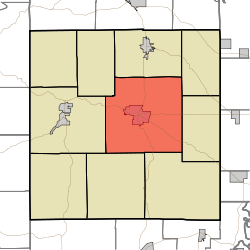
Chambersburg Methodist Church
The Methodist Episcopal church of Chambersburg was organized during the early 1840s and for the next few years meetings were held in private homes of the organizers and in school houses.
During the early 1850s, a frame church was erected, principally from labor of interested parties and from donations of members and friends of the organization.
Among the early members of this church are found these names: Daniel Robbins, Jane Robbins, Alexander Kearby, Joel Kearby, Edward Kearby, Robert Paschal, Mary Paschal, John G. Cadle, Milton Hobson, Hiram T. Lindley, Mrs. Caroline Baker, a number of Boyd families, Stewarts, and others.
The greater number of the regular ministers were supplied from the Methodist Episcopal church at Paoli. However, church services were discontinued many years since and the building has now been torn away, and no further church services are held in connection with this organization.
Chambersburg United Brethren Church
Following soon after the organization of the Methodist Episcopal church in Chambersburg, a group of Godly people organized the United Brethren church in Chambersburg, under Rev. L. S. Chittenden. At that time, the church was under the Washington circuit, and for several years thereafter this church alternated with the Methodist church in the use of the school building for church purposes.
A deed was secured for a church lot in 1864, at which time a frame house was erected on this ground.
Among the early members were Solomon Danner and family, Joseph Cox and family, William Gray and family, Joseph Moore, Elijah Purkhiser, J. T. Wolfe, R. S. Dillinger, and others.
From 1880 to about 1900, a parsonage for the charge was also located at Chambersburg.
While the society was never at any time numerically great, at times there were some very strong revivals which brought much activity in His service for extended periods. At the present time, however, the church is inactive, and the buildings have been torn away.
Mount Gilead — Methodist
This church, sometimes known as Sandy Hook, was the third in line of the early United Brethren churches in Orange county. It was organized by Rev. Jacob House in 1842 and is located two and one-half miles northwest of Paoli.
In the organization of this church we find the names of Wells, Claxton, Brown, Newton, Fullen, and Kimbrel families and with the very old pioneer citizens there began a very prominent church for many years. In recent years, because of roads and automobiles and the rural population going into the towns, the church membership is not so strong, but it remains active for church services and for funerals occasionally for the families of those who lie buried in the cemetery adjoining the church.
The present church building was erected in 1859 at which time a deed was secured for the church and cemetery ground. The church has been blessed with a great amount of ministerial work, and among the pastors who have so served the church, are listed the names of the following: A. H. Chittenden, John Riley, John Tucker, J. W. DeMunbrun, Z. B. Elledge, Albert and John Richardson, A. B. Condo, Daniel Shuck, Henry Trueblood, S. L. Todd, A. W. Arford, John Breeden, Thomas Elrod, A. C. Scott, Jacob Walls, Joseph Osborn, M. E. Apple, Porter Walls, W. J. Farnsley, J. W. Gilley and W. H. Lutes.
Orleans Township
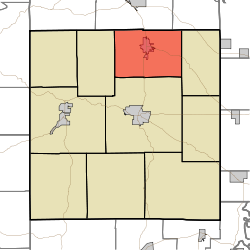
Union Church — United Brethren
This was the first organized United Brethren church society in Orange county, and is situated four miles southwest of Orleans, and about five miles northwest of Paoli.
This church was organized by John McNamar in 1828, in the home of Joseph Webb, Rev. McNamar being at that time a missionary sent by the Miami conference.
In 1830, at the first session of the Indiana conference, Rev. Frederick Kenoyer was assigned to the Orange circuit, and Union was the head of the circuit at that time.
The first church was a log building, erected in 1829, which stood not far from the present site. In 1845, they erected a frame building on the present site which they used up to 1903, when the present building was completed and dedicated for service. At the time of the building of this new church, the trustees were Thomas E. Lindley, L. F. P. Sanders, and W. G. Elrod. The contractor was W. H. Lutz, and the pastor at that time was Rev. Minnie Thorne. The church was dedicated by Bishop Carter the first Sunday in June, since which time, this date is kept as a regular anniversary date and home coming at this place.
Some of the early members of this church organization were the McPhersons, Stultzs, Stines, Webbs, Allegres, Jamisons, and Elrods, with others.
Out of this church came Rev. Thomas Elrod and his brother, Noah Elrod, who became well known ministers, and the Orange circuit, including this church, turned out 17 preachers from 1830 to 1860.
It is mentioned that originally this church, first known as Lost River and later and now commonly known as Union church, became a part of the French Lick circuit, and Paoli circuit, and at present, the Leipsic circuit.
We are advised that under Bishop Edwards, who gave the ground for the first church, that it is quite probable that ground was also included for cemetery purposes, which served until 1894, when additional ground for cemetery purposes was purchased of Thomas R. Martin. A little later, other ground was purchased for a community grove, and in 1937, other land was given for cemetery purposes by Albert Brown, of Paoli.
Among the ministers who have served this congregation, we are given the names of W. H. Lashbrook, U. G. Watson, Rev. Gilley, W. R. Gentry, J. P. Watson, J. M. Osborn, A. W. Arford, W. J. Farnsley, W. H. Lutz, A. B. Condo, M. E. Apple, S. P. Walls, C. L. Carmichael, C. H. Ivy, F. W. McKain, J. M. Hedge, I. S. McIver, Paul Sherrell, William T. Barker, with Rev. Leon Taylor as the present pastor who serves this church and Leipsic.
The present board of trustees in charge of this church is composed of five members, Alvis Lindley, W. G. Elrod, John Ellis, Charles Hudelson, and Carl Brinson.
There has been, and is now, a fine cultured people in this community and in this church, who have ever been wide awake to the service of the Master, and to the preservation of the community, whose pioneer seed in His name has been sown for so many years.
The first sentence of this paragraph makes little sense. It is reproduced here as it appears in the original.
With the beginning of this church school, which, for a time, was held organization, also begun a Sunday in the homes if the members of the organization. This sabbath school is still kept and has proven a very strong factor in the life of the church.
French Lick Township
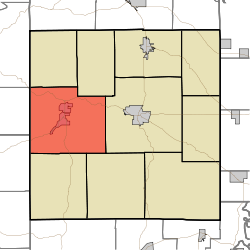
Moore's Ridge Methodist Church
This church is the outgrowth of the earliest Methodist church organization, which appears to be the first church organization of any denomination in the present boundaries of French Lick township. It was instituted in the home of one William Marley, near French Lick Springs in 1825, by a pioneer circuit rider named John Miller. Other than Mr. Marley, himself, we find among the names of the early members of this organization, Clayton Taylor, Alexander McGrew, and Joseph McGrew, with their wives and children.
The first church building was of log construction and was erected near the Marley home on what is now known as the Ryan farm, and in 1839, this building was destroyed by fire. Immediately, the organization began the erection of a new church on the farm now owned by Edward L. Claxton, south of French Lick, then known as the Bennett Grigsby farm.
The early history of this church records its destruction by wind storm in 1840, and a new building was erected some distance from the former where a cemetery had been started, with the first burial being a familiar figure of that vicinity, known as "Granny Crout."
The building served the congregation until 1882, when it was torn away and a frame building erected, this frame building serving the church until 1924, when it likewise was torn away and the present brick structure was built.
In the beginning of this church organization, we find it made up of the families of the Marleys, Moores, Newtons, Lashbrooks, Taylors, and others.
Since the building of the brick church the Kinseys with their surrounding neighbors and citizens of the community have been leaders in the church.
Among the first pastors of this church, we find the names of Marley, Moore, VanCleve, Gaskin, Winn, Blue, Pinnick, and others.
This church is now in a prosperous condition, in a real community center and much pride and forethought is given its annual meetings as well as to every service.
The present pastor of this church is Rev. Earl E. Denny.
Ames Chapel — Methodist
As a beginning of this church, we find this early history. A class of Methodists was founded in 1836, in the neighborhood of what later became known as Nelson Chapel, about one mile northeast of the present Ames Chapel church. Among the first members of this organization, we find the names of Allen Miller and wife, Davis Osborn and wife, William Stout and wire, Alfred Bruner and wife, and others.
In 1841, this organization erected a church known as Nelson Chapel, with Phillip May as the pastor, and Henry Talbott as presiding elder. In 1858, the late James P. Campbell was engaged as a local pastor to serve the church. Later, under the pastorate of Francis Walker, the class at Nelson Chapel divided. At this time, there was a class numbering about 80. A part of the class later became known as Smith Chapel, and met at the home of James Hicks, and there organized a Sunday school in 1858.
The year following, 1859, Smith's Chapel was built at a point on the old Paoli and Hayesville Road, about one-half mile east of the farm of the late Azor C. Smith. Benjamin R. Smith and William A. Charles are numbered among the first class leaders of this Smith's Chapel class.
In the fall of 1879, Nelson Chapel, located where Jessie Wilson's home now stands, 1¼ miles northeast of the present Ames church and Smith Chapel, then located one mile south of Abydel, consolidated and built a new church and called it Ames Chapel. Moses T. Ham donated three acres of ground, one acres to be used as cemetery, and two acres of ground for building and hitching places. Notley Harris was the contractor and Joe Morris and J. P. Campbell and others were the carpenters. The pastor who preached at Nelson and Smith Chapel and who lived at Paoli was Rev. M. S. Havenridge. In the spring of 1880, the church was finished and Rev. Havenridge held a revival meeting. Martha Ealle Stackhouse was the first convert and a wonderful revival came from this meeting.
This church was dedicated in July, 1880. Rev. P. F. Wells, was first pastor, then at Ames and Paoli; second, Rev. John W. Allen, and among others who followed were Rev. Miller, Rev. N. E. Boreing, Rev. Rader, who served five years, Rev. J. W. Baker, Rev.McCallister, Rev. Frank Hen, Rev. Breeden, Rev. J. W. McFall, Rev. Raaf, and Rev. O. E. Haley. This building burned May 10, 1913, at which time, Rev. J. W. Walker was district superintendent.
The trustees of the church were George A. Charles, Richard Lashbrooks, John A. Stackhouse, and Charles Pipher, and they, with other friends and members, build the present Ames Chapel. With Rev. E. O. Haley as pastor, this church was dedicated May 17, 1914, with a big basket dinner and a house full of people and pastors. At this time West Baden and Ames were put together. Following Rev. Haley was Rev. G. W. Holmes, who served three years, then the World's war, and the church was without a pastor for a while, having some older pastors at times. In 1916, Rev. Arthur Jean came. Then Rev. Carl Glick, Rev. W. L. Mitchell, Rev. N. F. Denny, Rev. Eugene Montgomery, Rev. O. H. Rumbley, Rev. E. E. Young, Rev. Harvon and Rev. James Austin, the present pastor. Some of these pastors served as long as five years. The daughter of the first convert in Ames Chapel, who has been a member for 24 years, has assisted much in gathering the facts of this church through older members, John A. Stackhouse, Lucy A. Lamdbin and others.
The church auditorium has recently been redecorated, and the present officials, in their true Christian spirit, are keeping alive and in good condition this beautiful church located between Paoli and West Baden Springs, on U.S. Highway 150.
Mount Lebanon Church — Methodist
This church is located about two miles southwest of French Like, on U.S. Highway 56, and at the time of its organization in 1840, was known as Scarlett Ridge class of a Methodist church. It was organized by one Rev. Johnson, and has among its first members, William and Samuel Scarlett, and their wives, Isaac Damewood, Mr. and Mrs. William Wininger, Harrison Hankins, and others.
The first meetings were held at the Scarlett schoolhouse, and soon afterwards a church building was erected in the town of French Lick. This building being destroyed by fire, they returned to the Scarlett schoolhouse for their services and later built a new church on the site of the old, and then gave it the name of Mount Lebanon, which name is yet carried.
For many years, this was known as a Mission church, and not until 1850 did it become a part of a regular established Methodist church, known as the Hayesville charge.
The present church building was erected in 1874 and 1875. It is commendatory to the members of this church organization that they were very active in helping to erect the first church within the present limits of the town of French Lick. The Mount Lebanon church is now a part of the French Lick circuit along with Moore's Ridge and points in Dubois county, and the pastor of this church is Rev. E. E. Denny.
It is noteworthy to say that this church enjoys the distinction in having three of its former members as present members of the Indiana conference: John H. Carnes of Richmond, now retired; Lemuel G. Carnes, of Lawrence, and William G. Morgan, Barth Place, Indianapolis.
This church maintains a Sunday school in connection with its other church activities, and among its early ministers, were John Julian, George Walker, Thomas Ray, and James Charles.
Sulpher Creek Church — United Brethren
The organization of this church was planned and principally carried out by Hugh McDonald, who, likewise, suggested the name by which it is known today. The first church house was built of logs in 1880, and served the congregation until November, 1905, when the building was destroyed by fire. The following year, a frame building was erected, which still stands. The land for the site of the church and the cemetery was donated by Mr. McDonald, who throughout his life, labored for the growth of the church.
One of the leaders in the organization was Rev. Simon Walls, and the first circuit rider to serve the membership was Rev. Inman. It was during the pastorate of Rev. A. B. Condo that the church burned, the occupants removing practically all the seats and furnishings of the church before it was destroyed.
The new church was dedicated in August, 1906, by Rev. J. M. Fowler, and it being the home church of Rev. Simon P. Walls, it is worthwhile to note that three of his sons, J. H. Walls, S. L. Walls, and S. P. Walls, each became preachers in the conference, two of the family, Rev. Simon Walls, who died in 1913, and Jacob H. Walls, who died in 1921, being buried in the cemetery near the church. The fruits of their labors still live, and the church is in a good working condition at the present time.
It is one of the active rural churches, and is located about four miles east of French Lick. Rev. Isaac McIver is the pastor at this time.
Highland Methodist Church
This church is situated about three miles north and west of West Baden Springs, and had its beginning in the early 1890s, when a class was formed in what was then known as the Buncombe school house. This class continued to worship for some time in this school building, until the present church house was erected.
Among the families connected with the Highland (Buncombe) class, are found the names of Alfred Tomlinson and family and Ellis Speece and family.
This church organization was a part of the Orangeville circuit for several years, and later was connected with West Baden charge. At the present time there is no active church organization here and only occasional services are held in this church.
Northwest Township
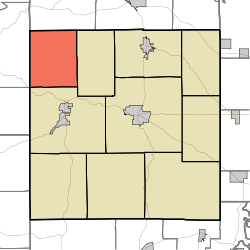
Faucett's Chapel — Methodist
This society was organized as early as 1837, in the home of James Faucett, whence comes it name. The organization was perfected under Rev. William McGinness, who was listed as a missionary for the organization of churches at that time. Among the names of those who became members of this organization and were influential in its growth and continuance, were given the names of James Faucett and his wife, Elizabeth, William and Hannah Faucett, Mr. and Mrs. John Brown, William Hamilton, James and Elizabeth Perine, Joseph Hamilton, and Susan Hamer.
For several years, church services were held in the homes of the organizing members, and it was not until 1847 that the first building was erected for church purposes, it being a log building and the pastor at that time being Samuel Hicks.
The records give the names of trustees as follows: J. L. Brown, William Hamilton, James Perine, Eli H. Faucett, and William Faucett.
This church building served the purpose of the congregation until 1879, when a nice, new frame house was erected at a cost of more than $1000, and this church still serves its membership. While the congregation is not so active as in former years, yet to many of those who affiliated with that church for so long, and the memories that it brings of the loved ones who are gone, it is yet a community center, full of interest and affection for those of its members who remain.
A later section says more about Faucett's Chapel,
accompanied by this disclaimer:
Note: This additional information was furnished the writer
by Wayne Chastain, of Mitchell, Indiana, a grandson of
David T. Robbins, for many years a leader in the church,
and was copied from a paper prepared by the Rev. N. F.
Denny, and is perhaps authentic.
For a period of more than 100 years, there has been a worship known as Faucett's Chapel class in Orange county. The society was organized in the home of Mr. and Mrs. James Faucett in 1837. The organization was said to have been perfected by one Rev. William McGrimes, who was listed as being a missionary for the organization of churches about that time.
About that time came one Lorenzo Dow into the county, a minister who claimed the world for his parish, and one among his converters was Mary Wilson Bruner, mother of the late William A. Bruner. Others who were listed as becoming members of this class were Elizabeth William and Hannah Faucett, Mr. and Mrs. John Brown, grandfather of the late Lewis P. Brown, William Hamilton, James and Elizabeth Perrin, Joesph Hamilton, and Susan Hamer.
For many years church services were held in the homes of various members. In 1847, James Faucett Sr. gave the land upon which the first church was erected, it being a log building, with Rev. Samuel Hicks in pastoral care at that time. The trustees are listed as being Eli and William Faucett, Johnathan L. Brown, William Hamilton, and James Perrin.
Its various ministers were of the "circuit-rider" type of that day, who traveled on horseback from the east into the western wilderness, with the saddlebags containing hymn books and Bibles, and held religious services in the homes of members, preaching a Gospel of power, organized religious societies, built churches, risked and sacrificed all — even life itself — and left a rich heritage to all the world.
For a few years this log building served the double purpose of church and school, and one of the early teachers here was Ruth Hobbs, sister of Rev. W. P. Hobbs. Later she became the wife of L. D. Miller, and the mother of Samuel, Harry, L. O., and Dow Miller, well known in the county.
The log building served the congregation until 1879, when a new frame building was completed, at a cost of more than $1000, and this building has served its membership since. Among the families who have labored for the service of the Master in more recent years have been the Millers, Browns, Hamiltons, Faucetts, Collins, Southerns, Dickeys, Pruetts, Hatfields, Gerkins, Kenyons, Duncans, Pinnicks, Ritters, Robbins, Hobbses, and Dennys. From these families have gone forth many teachers and business men, and women whose lives have helped to shape the destiny of a community, a county, and a state.
And in the continuity of a service for the Master, this little church on the hillside in the wildwood has perhaps sent out more ministers for the Methodist Episcopal conference than have been sent out from any other church in the county. Among these we are given the names of Revs. N. F. Denny, C. H. Pinnick, E. T. Gerkin, George Godwin, Stafford Godwin, and Angie Godwin, the last named being the founder of the Methodist orphanage at Lebanon, Indiana. And as worthy helpers to these ministers, we are told there has gone out from this church wives for ministers as follows: Lydia L. Southern, as the wive of Rev. N. F. Denny; Anna Henson, wife of Rev. E. T. Gerkin; Dora Duncan, wife of Rev. Reynolds; Josie Hatfield, wife of Rev. Lem Grigsby; Maude Godwin, wife of Rev. Street; May Robbins, wife of Rev. A. E. Chastain; and Miss Anna Gerkin, who became the wife of a Methodist Episcopal minister in Iowa.
The records show the name of 48 ministers who have served this church, most of whom, with the membership who served its early days, are now gone. May it be said of them, they have gone to their crowning, and their works do follow them.
Scarlet Chapel — United Brethren
This likewise was one of the early United Brethren churches in the county. It was organized in 1846 by Rev. L. B. Lacy. A log church house was used until 1859, when they secured a deed for a church lot on which was erected a frame building.
This has been one of the leading community centers in the church life of Northwest township, is still active, and is now served as part of the Shoals circuit by Rev. Robert Hawkins. Other pastors whose names have been given are Rev. Moran; Rev. Brett; W. C. Courtwright; Rev. McKibbens, and William Brothers. The leading members of the church as given at this time, are Mr. and Mrs. Al Scarlett, Frank W. Jones, Mr. and Mrs. Ralph Holden, and Mrs. Horace McKibbens.
Bond's Chapel — Methodist
This church, while not as old as some of the other churches of the township, and though we have been unable to get as much data concerning its life as has been given of some other churches (all of which have been brief), nevertheless, Bond's Chapel can not be considered as one of the unimportant church organizations of the county.
The Christian spirit of its founding is kept in its name, coming from the Rev. John Bond, a Methodist Episcopal minister, who donated the land about 1850, upon which the first church — of hewn logs — was erected. This church served the congregation until 1881, when the present building was erected on land purchased from the Hiram Kirk heirs for a church site and cemetery plot. The old building was old and is yet in use as a farm building on the farm of Oscar Meehan.
The church has been served by many pastors, among whom we are given the names of Revs. Shively, Allen, Elrod, Julian, Davidson, Crowe, Morgan, Walls, Downing, Suddarth, McClure, Bivins, Shearer, Hartsaw, McMicheal, Kinneman, and Austin.
Services are still maintained. Located in a beautiful grove, with a well-kept cemetery and surroundings, it maintains its standard as a community center in Northwest township.
Orangeville Township
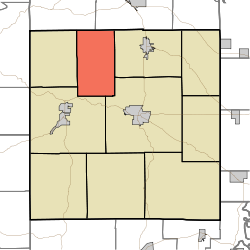
Orangeville Church — Methodist
Under the pastorate of Rev. George W. Walker, of the Orleans circuit, a board of trustees, composed of William P. Hobbs, Harvey Denny, Lewis B. Wilson, Robert Higgens, and Alfred Bruner, were elected on January 10, 1851, for the erection of the Orangeville Methodist Episcopal church.
On November 4, 1851, Nathaniel B. Wilson and wife deeded the lot on which the church now stands, and during the remainder of that year, and the early spring following, the church building itself was erected. One of the interesting things in the erection of this church is shown by an old record which shows that Hicks and Denny furnished 650 feet of clear poplar lumber for the seats in this church, at a cost of $6.50.
The main part of the erection of the building was done by Harvey Denny and it is further shown that Dr. John A Ritter, lately deceased, lathed and plastered this building.
This building remained as originally built until 1930, when it was remodeled under the supervision of the late Rev. M. F. Denny, then pastor at this place, and since that time, beginning September 17, 1939, electric lights were installed for the use of the building from the new county rural electrification.
During the time this church has been in existence, some 60 ministers have served the pastorate here, most of them being connected with other churches in this section.
In the history of this church, we find that for a time the Methodist churches were grouped in circuits and in 1852, the Orleans circuit became independent from the others, and Orangeville circuit was known as the Orangeville Mission and consisted of Methodist organizations and classes of what was then known as Bruner's (now Wesley Chapel), Faucett's Chapel, Bond's Chapel, and others, and during the time of this mission, a revival was held at Orangeville by the Rev. Thomas A. Whitted in which more than 100 converts were added to the church roster and the influence of this wide-spread membership has been retained with that organization.
Wesley Chapel Church — Methodist
This church was founded in 1857, the leaders in the early organization being Alfred and Mary Bruner, Henry and Sarah Bressie, Nathaniel B. Wilson, Thomas L. Mathers, George Shirley, Nathaniel W. Britton, and others of that community.
On December 24, 1857, Alfred and Mary Bruner deeded the land for the church building off of what is now known as the James Elrod farm, and on the same day, Henry and Sarah Bressie deeded land to the church on the west side of the roadway, the land from which it was conveyed now belonging to Mr. and Mrs. Clarence Chatham.
Nathaniel Wilson, Thomas L. Mathers, George Shirley, Nathaniel W. Britton, and Alfred Bruner were the first trustees and the church building was erected in 1858 by Samuel Hicks and Harvey Denny. The building still stands and is in a splendid state of preservation, having been kept in good repair, well painted and well roofed all these years. Much of this work has been done directly by the membership of that community, who have also considered it a community center, and it is still held in that esteem. The interior of the church and preservation of the community spirit has been done in large part by the ladies of that community, even though they may adhere to other church affiliations, and this work has extended to a new floor in the building, new carpets, electric lights, and other interior decorations which have added much to its appearance.
A Ladies' Aid of the church was organized in 1932, under the pastorate of Joseph L. Sout, then regular pastor of the Paoli Methodist Episcopal church. Mr. Stout also had much to do with the beautification of the church lawn, and of the church building itself. This has continued under the leadership of Mrs. Charles Mathers until the lawn itself has been made more beautiful through the plantings and the donation of plantings for this purpose by R. A. Troth, of Orleans, and the assistance of men of the community.
A list of the ministers who have served this church has been well kept, and though served by many pastors, often regular pastors of other churches, this list is as follows:
| I. N. Thompson | 1858-1859 |
| W. E. Ravenscroft | 1860 |
| E. L. Kemp | 1861 |
| David Swartz | 1862 |
| W. P. Armstrong | 1863-1864 |
| A. W. Shively | 1865-1866 |
| Lawrence Jones | 1867 |
| G. M. Hilliard | 1868 |
| J. V. Moore | 1869-1870 |
| S. H. Talbott | 1871 |
| H. W. Welker | 1872 |
| N. E. Boring | 1873-1874 |
| G. W. Houpt | 1875 |
| C. W. Woods | 1876 |
| R. W. Julian | 1877 |
| John Speer | 1878 |
| H. W. Wright | 1879 |
| H. T. Allen | 1880-1881 |
| S. L. Culmer | 1882-1883 |
| Newt Elrod | 1884-1885 |
| W. H. Davidson | 1886 |
| George M. Puett | 1887 |
| John Crowe | 1888 |
| N. F. Denny | 1899-1890 |
| W. H. Headen | 1891-1892 |
| T. N. Heaton | 1893 |
| W. S. McMichael | 1894-1895 |
| F. W. Davis | 1896-1897 |
| C. W. Manpin | 1898-1899 |
| T. G. Tone | 1900 |
| W. G. Morgan | 1901-1902 |
| G. R. Walls | 1903-1904 |
| W. S. Suddarth | 1905 |
| G. A. Emerich | 1906 |
| G. W. Speedy | 1907 |
| Valentine Dietch | 1908 |
| Arthur Bentley | 1909-1911 |
| Oscar Luck | 1912-1913 |
| H. W. Bybie | 1914 |
| E. W. Scarber | 1915 |
| W. A. Hartsaw | 1916 |
| P. H. Downey | 1917 |
| A. J. Shearer | 1918 |
| R. D. Beven | 1919 |
| R. Callison | 1920 |
| C. C. Kinneman | 1921 |
| C. M. Hewilt | 1922-1923 |
| Robert Hamm | 1924-1925 |
| D. R. Johnson | 1926 |
| H. D. Bassett | 1927 |
| R. O. LaHue | 1928 |
| L. C. Murr | 1929 |
| M. Brittingham | 1930-1931 |
| Joseph L. Stout | 1933 |
| E. E. Young | 1933-1935 |
| J. E. Harbin | 1936 |
| James Austin | 1937-1939 |
Northeast Township
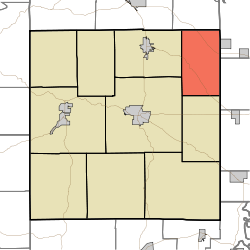
Island Methodist Church
Along about the year 1850, a few neighbors got together and organized a church and called it the "Island Methodist Church." This church was built by Mark Ferguson. Some of the charter members were: Joseph A. Tegarden, Henry Monyhan, Robert Walker, David Worrell, James Fisher, George Peters, and Dr. Hobbs. In years past this church was voted as one of the leading churches of the community, and as a great community center, a place for picnics, school exhibitions, and a general place of interest to young and old. During series of meetings there wouldn't be standing room in the building and people would be standing on the outside. As death called one by one of the older members, the church began to go back and at the death of Mr. Monyhan, it seemed as though the interest was gone, and in 1910 or 1911 the church was disbanded and later, in the year of 1916, the building was sold to the late Fred Walker for the sum of $200.00, and the land to W. H. Walker for $49.00. At this time the members were transferred to the Orleans Methodist church and other nearby churches.
The "Island" will always be a sacred place in the hearts of those who remain to look back and think and talk of the place that was so dear in the hearts of their loved ones, long a sacred spot in the southeast quarter of section 2, township 2 north, range 1 east.
There are but very few left to tell of the happy days that were spent at the "Island."
Leipsic United Brethren Church
Leipsic is a little town of small circumference on the Monon railroad, east of Orleans, but its citizens are large in their belief in the work of the church, and to these few citizens and the strength they have helped to gather from the surrounding community is due the success of its organization.
One among the leading persons who was interested in the founding of the church was Mrs. Minnie Thorne, a devoted minister of the United Brethren faith, and it is also much through her efforts in 1910 as a leader that this church was organized.
In 1912, a deed for the land was secured and a frame building was erected, which has continued to be one of the more active churches among the community since its organization.
In a brief history of this church, Rev. A. B. Condo mentions the "reverting" clause in the deed to the land prohibiting its sale at any time in the future, should the church desire to locate elsewhere.
Stampers Creek Township
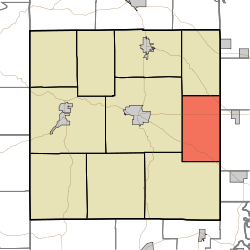
Danner's Chapel — United Brethren
As far as we are able to learn, this church was organized by Aaron Farmer in 1829, being the second United Brethren church in the county, and the Rev. Frederick Kenoyer was given this circuit as a minister in connection with that of Union church.
The organization was affected in the home of one Joseph Danner, and they continued to worship in his home until 1893, when they erected a log house which was to be used jointly for church and school purposes.
They continued to worship here until 1841, when a frame house was erected, which is still standing today, though not in active use, but is used occasionally for funeral purposes.
The deed for church and burial ground was made by Joseph Danner to James Danner, Andrew Danner, and Joseph Danner, who were trustees for this church. This deed was made Jam. 9, 1851.
Alive now are but few of the people who were members when this church was active, but at recent times there has been talk of reviving this organization and re-establishing a church society at this historic spot.
Jackson Township
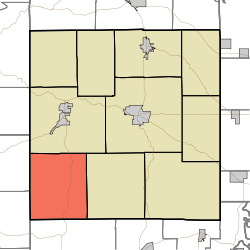
Wesley Chapel — Methodist
In about 1860 the Bruebecks, Eastridges, Gilliatts, and other families of that community gathered together for the organization of a Methodist church organization. For some time the church services were held in the homes of families in that community and in the school houses nearby. Later a building was erected for these services and continued to the present time. The present pastor now serving this church in regular meetings is Reverend Coats.
Newton Stewart United Brethren Church
In 1884, under the direction of Rev. J. A. Richardson, whose name is mentioned elsewhere in connection with the United Brethren church in this county, an organization was perfected among the families of Jess Tucker, Taylor Dillard, Joseph Whitmire, and others as a church organization and for several years church was held in the school building and in the homes of families nearby.
A deed for a lot for a church building was received by the trustees in 1896 and in 1897 a good frame building was erected. Earlier than this, perhaps during the 1840s, there had been a log house about 1½ miles north of Newton Stewart where the United Brethren faith had worshiped. This place was known as Newton's Ridge and after the new building was completed the church organization was connected with it. The old building stood for many years, although not used as a church.
This church is now used more as a union church with Rev. Taylor as its pastor.
Mount Zion Methodist Church
In 1906 the families residing in the northwestern part of Jackson township felt the need of a distinct church organization to serve that locality and with the direction and influence of the families of Pennicks and Eastridges, and others living in that community a church organization was perfected and a building was erected for that purpose.
This church now retains a good organization, and is kept in splendid condition, is made a community center for other Christian activities, and is served by Reverend J. Dickson.
Greenfield Township
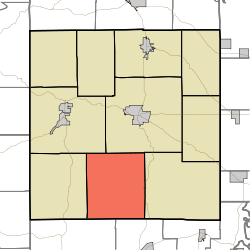
Apple's Chapel — United Brethren
This church was organized in the home of John Apple in 1847 by Rev. S. B. Falkenburg.
We are advised that at about the same time the beginning of an organization was made in the home of Thomas Apple, another of the religious pioneers of that community but it is not shown that any direct church organization was perfected.
On March 6, 1855, John Apple made a deed to the United Brethren church trustees, who at that time were John Apple, William R. Apple and Moses Apple, and from that date this church and community has been a United Brethren center. While not as strong as in former years, because of death and removal of members, they do however maintain a church society, and a community cemetery, both of which are kept in good condition and are much cherished by the older residents.
Recently an improved road has been built by the church which makes access much better and will no doubt bring about better standing and growth of the church.
Ministers following Rev. Falkenburg were: Daniel Shuch, Lyman Chittenden, John A. Richardson and others.
Soon after the organization, a log church was built and served its members until 1877 when the present frame building was erected at a cost of $600.00 and much free labor.
McDonald Chapel — United Brethren
This church is located near Ethel, in the southern part of Orange county. The same Rev. Joseph M. Osborn, who was instrumental in the organization of the Harned Chapel, United Brethren church, in Southeast township, was likewise the organizing head of this church. From the records of the Rev. A. B. Condo, we gather that the church was organized in 1891, and in 1894, a deed was secured to 1½ acres of land from William McDonald and William Pruett, upon which a building was erected, and was dedicated in 1895.
Among those who were active in the organization of the church, we find the names of Moses and Nancy Jane Roberts, Thomas and Luvica McDonald, William McDonald, John and Bina Roberts, Charley and Amelia King, John T. Apple, Davis Pruett, and Mary Pruett.
Many members have been added since its organization, and among them we find the names of William, Annie, Minnie, Nancy, James, Ella and Samuel King; Elijah, Mary Ellen, Edward, Effie, Thomas, and Iona Pruett; Ella and May Robbins; Eli, Alice and Nellie Apple; William and Elzora Walton; Ada Gilliatt; Mattie Land; Mary J. Smith; Floyd Patton; Ben Walls and Emma Walls; Mr. and Mrs. William Hammond; Verl and Kenna Hammond; Dorothy and Fern Pruett; and Amy Hollen.
After its organization, Joseph Osborn became its first pastor, with Charley King, Thomas McDonald, and William McDonald as its first trustees. Other pastors who have served the church are Rev. W. H. Lutz, O. P. Danner, M. E. Apple, Lincoln Hobson, Rev. Turley, Simon Walls, Rev. Esque, Charles Galloway, Rev. Simcox, Porter Walls, James Bradford and David Owns, the last named serving the church at this time.
The present trustees of the church are William Hammond, Floyd Patton, Eli Apple, Thomas Pruett, and Charles E. Pruett. Under their direction, the church was repaired in 1923, and is now in good condition.
Southeast Township
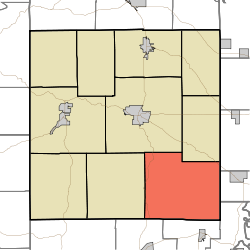
Harned Chapel — Methodist
This church is listed in connection with what is now known as the Harned Chapel United Brethren church, because the first church organization was founded by the Methodist church three miles southwest of Valeene in 1845. The original church was of log construction, later being weatherboarded, and for many years was used by the Methodist organization, having among its membership the names of Thomas Harned and family, the Dillards, Sloans, Crandalls, Stones, and others of that vicinity of that period. During the time of the continuation of this church organization, William, Michael, and John Harned became ministers in the work of that church. A strong Sunday school class was likewise kept in connection with the church services.
Later with the changes which time often brings, this church was discontinued entirely, and the grounds and the building were purchased by a United Brethren organization and became a church of that faith, but retaining the same name. A new building was erected some little distance from the old and continues its worship today as:
Harned Chapel — United Brethren
It is one of the later United Brethren churches established in Orange county, being organized by Rev. J. M. Osborne in 1891, by and with the assistance of James Trinkle, Volney Stone, Joel Denton, Bal Moon, and others.
In 1894 a frame building was erected upon land deeded to the organization by Thomas Crandall, and in the fall of that year the new building was dedicated by Rev. A. B. Condo, a well-known United Brethren minister, and one who has perhaps done more to perpetuate the history of the United Brethren churches in Indiana than any other one person.
The church today has a small membership, but a community of friends who are interested in the church and give of their support to it, and make of it a very active community center. It has a strong Sunday school and is very active in this work. Among its present membership are found the names of Mr. and Mrs. Ott Dooley, Mrs. W. T. Richelberger, David Apple, Mrs. Andrew Redden, Mr. and Mrs. Perry Moon, Mrs. George Landreth, Mrs. Emma Walls, and others. With these there are several who retain their membership here, but are living in other localities.
As pastor of the church, it is now under the care of Rev. David Owens of Paoli. Others who have served the church in this capacity during its existence are Johnny Richardson, Simon Walls, Porter Walls, M. E. Apple, Thomas Kendall, I. S. McIver, Charley Galloway, Rev. McClure, and perhaps others. It remains to a "church by the side of the road," eager to continue in its service of praise, and in the spread of good fellowship throughout the land.
Concord United Brethren Church
The church organization known as Concord was organized in 1865, and in 1867, they received a deed for church ground upon which was erected a log building, in section 32, township 1 north, range 1 east. This building was used for more than 25 years. During the pastorate of Rev. U. G. Watson in 1892 and 1893 the present frame church was erected.
We are not able to say definitely as to who organized this church, but most probably it was Rev. Thomas Elrod, Rev. James Granger, or Rev. J. W. Daugherty, all of whom served this church and were instrumental in bringing the organization to great work in that community.
The church is located on the Paoli—Valeene road, has a fair membership, and while regular services are not held, the church is frequently used for Gospel services, for funerals and as a center for community activities.
Concord United Brethren Church
The church organization known as Concord was organized in 1865, and on September 28, 1867, a deed for church ground was received from Isaac and Catherine A. Granger, in section 32, township one north, range one east, and a log building was erected thereon. This building was used until 1905, when the second church and present one was erected, during the pastorate of Rev. U. G. Watson.
We are not able to say definitely as to who organized this church, but probably it was Rev. Thomas Elrod, Rev. James Granger, or Rev. J. W. Daugherty, all of whom, together with O. P. Danner, Rev. Gilley, Rev. Watson, M. E. Apple, Porter Walls, Clifford Dillman, Rev. Turley, Rev. Simcox, Rev. Kendall, Charles Golloway, and Rev. McIver, the present pastor, have served this church. One among the older trustees of the church was Joel Newlin. We have not been able to learn the name of other trustees of the early church. The present trustees are John Denton, Dale Patton, and Perry McCabe.
The principle active members of the church at this time are Mr. and Mrs. John Denton, Mr. and Mrs. Dale Patton, Mrs. Lizzie Holaday, and Mr. and Mrs. Jerry Eickelberger, who, with others, both past and present, have been instrumental in bringing this church organization to a great work in that community.
Early in the history of the church, additional land was given to the church organization for cemetery purposes, and is still held by the church for that final service.
